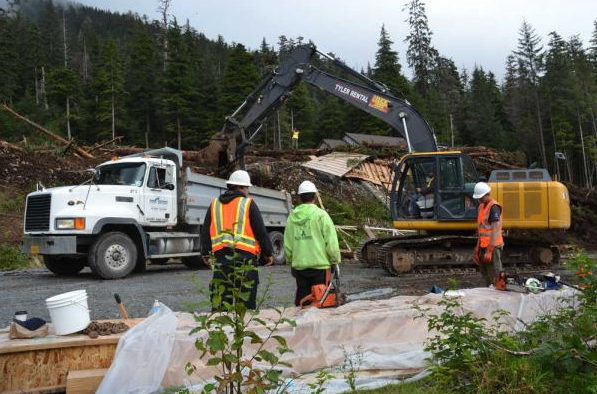SITKA — The state has received federal funds to conduct a comprehensive landslide hazard assessment of Sitka after slides there last year left three people dead and caused $1 million in damage.
Officials announced the grant from the Federal Emergency Management Agency on Tuesday. De Anne S.P. Stevens with the Alaska Division of Geological and Geophysical Surveys said the study will include landslide mapping and hazard modeling for about 25 square miles, enough to cover the entire populated area of Sitka, The Sitka Sentinel reported.
The assessment will use data collected earlier this year through lidar technology, in which laser beams are used to measure the elevation of the ground.
“It allows us to generate a 3-D topographic land level map from which we can strip all trees and vegetation and look at what’s going on underneath,” Stevens said. “It’s incredibly useful for analyzing any sort of land surface process. Things like geomorphology … looking at unstable slopes, old drainage channels. There’s a lot we can see.”
The lidar data was gathered under a partnership between DGGS, the National Park Service and the U.S. Army Corps of Engineers.
The interest in studying Sitka came about following the deadly landslides on Aug. 18, 2015, Stevens said.
“This struck close to home – everybody’s hyper-aware we need to understand the hazard, especially in urbanized areas. … We really need to take it seriously,” she said.
The Sitka Assembly had hired geotechnical firm Shannon & Wilson to conduct a study of the area where the three people were killed. The company presented a report to the Assembly in February detailing potential risk areas for future slides and a warning against moving forward with construction activity without further examination.
City Administrator Mark Gorman said Sitka will allow the DGGS to conduct its mapping work before more studies of other parts of the city are done.
“By doing it comprehensively it doesn’t highlight certain neighborhoods, which may disadvantage and impact land values,” Gorman said. “I think it’s more even-handed to do it all at once. … It will be easier to accept the fact that there is an inherent risk whether you’re living at sea level or living on a hill. It’s more responsible approach to do a comprehensive look at the community, rather than piecemealing it out.”
The state’s assessment should be complete within two years, Stevens said.
—
Read more news:
US wants to strengthen agreement to ban Arctic Ocean fishing
‘There’s no fighting back’: Hoonah hunter recalls being in the grip of a brown bear

